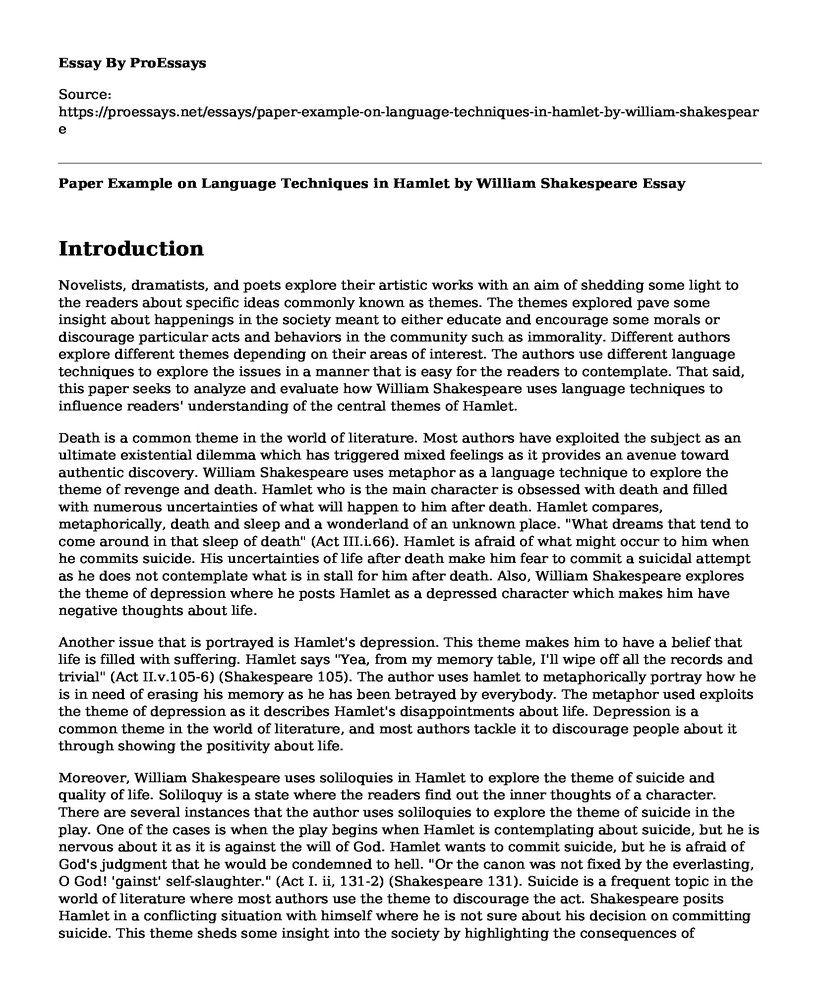Introduction
Novelists, dramatists, and poets explore their artistic works with an aim of shedding some light to the readers about specific ideas commonly known as themes. The themes explored pave some insight about happenings in the society meant to either educate and encourage some morals or discourage particular acts and behaviors in the community such as immorality. Different authors explore different themes depending on their areas of interest. The authors use different language techniques to explore the issues in a manner that is easy for the readers to contemplate. That said, this paper seeks to analyze and evaluate how William Shakespeare uses language techniques to influence readers' understanding of the central themes of Hamlet.
Death is a common theme in the world of literature. Most authors have exploited the subject as an ultimate existential dilemma which has triggered mixed feelings as it provides an avenue toward authentic discovery. William Shakespeare uses metaphor as a language technique to explore the theme of revenge and death. Hamlet who is the main character is obsessed with death and filled with numerous uncertainties of what will happen to him after death. Hamlet compares, metaphorically, death and sleep and a wonderland of an unknown place. "What dreams that tend to come around in that sleep of death" (Act III.i.66). Hamlet is afraid of what might occur to him when he commits suicide. His uncertainties of life after death make him fear to commit a suicidal attempt as he does not contemplate what is in stall for him after death. Also, William Shakespeare explores the theme of depression where he posts Hamlet as a depressed character which makes him have negative thoughts about life.
Another issue that is portrayed is Hamlet's depression. This theme makes him to have a belief that life is filled with suffering. Hamlet says "Yea, from my memory table, I'll wipe off all the records and trivial" (Act II.v.105-6) (Shakespeare 105). The author uses hamlet to metaphorically portray how he is in need of erasing his memory as he has been betrayed by everybody. The metaphor used exploits the theme of depression as it describes Hamlet's disappointments about life. Depression is a common theme in the world of literature, and most authors tackle it to discourage people about it through showing the positivity about life.
Moreover, William Shakespeare uses soliloquies in Hamlet to explore the theme of suicide and quality of life. Soliloquy is a state where the readers find out the inner thoughts of a character. There are several instances that the author uses soliloquies to explore the theme of suicide in the play. One of the cases is when the play begins when Hamlet is contemplating about suicide, but he is nervous about it as it is against the will of God. Hamlet wants to commit suicide, but he is afraid of God's judgment that he would be condemned to hell. "Or the canon was not fixed by the everlasting, O God! 'gainst' self-slaughter." (Act I. ii, 131-2) (Shakespeare 131). Suicide is a frequent topic in the world of literature where most authors use the theme to discourage the act. Shakespeare posits Hamlet in a conflicting situation with himself where he is not sure about his decision on committing suicide. This theme sheds some insight into the society by highlighting the consequences of committing suicide.
Finally, William Shakespeare uses imagery to portray the theme of corruption. William used poison, disease, and decay to apparently bring out the subject of corruption. William relates corruption to the poison that is evident when King Hamlet was poisoned. Also, the decay of the empire that is portrayed through disease and war represents corruption in the society. Corruption is often related to the evils of the community. Poison, disease, and war are some of the atrocities witnessed in the community. "In the state of Denmark, something is rotten (Act I, IV, 90)" (Shakespeare 90). This quote indicates the moral decay in the societies today. Corruption is a frequent topic in the world of literature that is covered by most authors to provide more profound insights on the consequences of corruption in the society as well as discouraging it.
Conclusion
In conclusion, William Shakespeare has intertwined literary devices and central themes in his play Hamlet. Shakespeare uses a variety of literary devices to influence the audience's understanding of the central issues and ideas in the book. Although Shakespeare uses some techniques to give an in-depth knowledge of the characters and the story, the better part of the play uses Soliloquies to explore the central themes. These techniques express the emotions of the characters thus providing a better understanding of the issues to the audience.
Work Cited
Shakespeare, William. Hamlet. Classic Books Company, 2001.
Cite this page
Paper Example on Language Techniques in Hamlet by William Shakespeare. (2022, May 16). Retrieved from https://proessays.net/essays/paper-example-on-language-techniques-in-hamlet-by-william-shakespeare
If you are the original author of this essay and no longer wish to have it published on the ProEssays website, please click below to request its removal:
- Critical Essay on Theme of Pride in Persepolis by Marjane Satrapi and the Kite Runner by Khaled Hosseini
- Literary Analysis Essay on Marie Howe's Poem "What the Living Do"
- Is Macbeth a Tragic Hero or a Villain?
- Eileen Chang: Iconic Writer and Hall of Fame Icon - Essay Sample
- American Realism: A Faithful Representation of Reality - Essay Sample
- Essay Example on Comparing Wordsworth and Sidney: Sleep Poems
- 1984: Exploring Oceania's Totalitarianism & Achievements - Essay Sample







